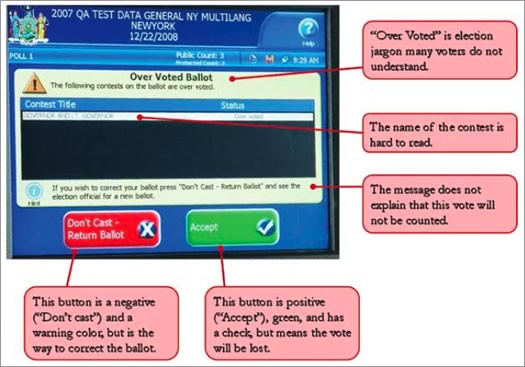Mind your ovals, please

A diagram from the report critiquing the voting machine error message.
There was many as 60,000 votes tossed in the 2010 election New York because of "overvotes" -- that is, people filled in too many ovals on their ballot -- according to a report from the Brennan Center. The report's authors figure that 20,000 voters in the state didn't have their vote for governor count because of an overvote problem.*
From the report's executive summary:
In modern history, New York has never seen so many lost votes due to overvoting. Unlike the new optical scan voting system, New York's old lever machines did not allow overvoting. But even so, the numbers of lost votes due to overvoting in 2010 were far greater than they should have been. Overvotes are almost always unintentional. A well-functioning voting system, even one that includes optical scan equipment, should have overvote rates very close to zero. ...
Black and Hispanic voters were at least twice as likely to lose votes due to overvoting as non-Hispanic whites. Shockingly, in two Bronx election districts, nearly 40 percent of the votes cast for governor were voided as overvotes.
The Brennan Center, and other good government groups, have argued that the error messages returned by machines for overvotes are hard to understand -- because of jargon such as "overvote" or a confusing user interface -- and as result, people don't realize they've made an error, or can't understand how to fix it. Proposed solution: change the error messages to plain language such as: "you have filled in too many ovals."
The full report is embedded after the jump.
* Not that this would have affected the outcome. Even if they were all Paladino voters, Andrew Cuomo would have still had about a 1.3 million vote lead.
Say Something!
We'd really like you to take part in the conversation here at All Over Albany. But we do have a few rules here. Don't worry, they're easy. The first: be kind. The second: treat everyone else with the same respect you'd like to see in return. Cool? Great, post away. Comments are moderated so it might take a little while for your comment to show up. Thanks for being patient.
Comments
As someone who worked at a polling place on Election Day I can say that while there were several instances of over-voting, the workers at my place always made it a point to explain to the voter what had happened. Further, most, if not every single person who over-voted and was explained what it meant, still chose to cast their ballot anyway, invalidating the race on which they overvoted. I realize that the voters in any one particular polling place probably aren't a representative sample but my particular place consisted mostly of elderly voters who seemed annoyed by the overall electronic process to begin with. I wonder what the statistics would show if they were broken down by age groups as well.
Also, I'm not sure that I agree that the phrase 'you filled in too many ovals' versus 'there was an overvote' requires any less explanation and, as I said previously, explaining the situation made little difference in the decision to cast the ballot anyway.
... said Drew on Dec 8, 2011 at 12:24 PM | link
I also work at a polling place and have worked elections for the past several years, from the before the optical scan machines to now. We always explain to voters what the overvote means and like Drew the vast majority of voters choose to cast anyway. The major reasons given by these over-voters who "cast anyway" are "don't have time to fill out another one" and pure apathy / "can't be bothered."
The machine makes it clear what was overvoted, and as far as the "green vs red" color on the buttons, the person writing that report assumes that the voter wants to correct the vote hence wants that button green. Perhaps the vendor knew something that the report author didn't - that most people don't want to correct their vote.
I personally do agree that some UI (user interface) changes could be made to that screen, but I want to defend the fact that like Drew we poll workers are there to help the voters with all aspects of voting - from understanding the ballot itself, to filling it out, and casting it in the scanner/ballot box. In the end, the voter has the final say - whether the author of the report (or us) likes it or not.
... said Drake on Dec 9, 2011 at 2:08 AM | link
Like the other two, i am an election inspector. One of the people at my table was telling the voters to circle the ovals! That made them null, and void. When i heard that i corrected him.Most of the problems were .because people didn't know where to vote.When they were told they had to vote at another polling place some said they couldn't be bothered.
... said mg on Dec 9, 2011 at 9:50 AM | link